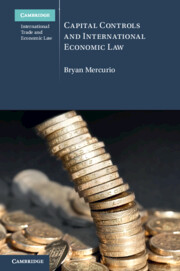Book contents
- Capital Controls and International Economic Law
- Cambridge International Trade and Economic Law
- Capital Controls and International Economic Law
- Copyright page
- Contents
- Foreword
- Preface
- Acknowledgements
- Abbreviations
- Part I Key Concepts: Capital Flows and Controls
- Part II The IMF, Capital Flows and Controls
- Part III Legal Frameworks, Rules and Conflicts
- 5 The Multilateral Trade Framework
- 6 Bilateral and Regional Trade Agreements
- 7 International Investment Agreements
- 8 Conclusions
- Bibliography
- Index
6 - Bilateral and Regional Trade Agreements
from Part III - Legal Frameworks, Rules and Conflicts
Published online by Cambridge University Press: 18 May 2023
- Capital Controls and International Economic Law
- Cambridge International Trade and Economic Law
- Capital Controls and International Economic Law
- Copyright page
- Contents
- Foreword
- Preface
- Acknowledgements
- Abbreviations
- Part I Key Concepts: Capital Flows and Controls
- Part II The IMF, Capital Flows and Controls
- Part III Legal Frameworks, Rules and Conflicts
- 5 The Multilateral Trade Framework
- 6 Bilateral and Regional Trade Agreements
- 7 International Investment Agreements
- 8 Conclusions
- Bibliography
- Index
Summary
FTAs have become a major conduit for developing and organising a legal framework for capital movements across borders. While FTAs contemplate the liberalisation of signatories’ capital account and the facilitation of payments and transfers as a means to foster trade in goods and trade in financial services between countries, the agreements do more than simply require the free flow of capital. Indeed, FTAs also provide a variety of exceptions and carve-outs aimed at providing regulatory policy space. The amount and degree of policy space differs between and among agreements, but the trend is for treaties to include more and stronger protections. This chapter analyses typical provisions relating to financial services found in FTAs before turning to common FTA exclusions and exceptions. In so doing, four modern agreements are extensively referred to as examples – CPTPP, USMCA, RCEP and CETA. While many obligations and exceptions are based on and resemble the GATS, the provisions contained in FTAs can be deeper and more comprehensive than those of the multilateral trading system. Properly drafted, such FTAs should provide comfort to governments seeking to make use of targeted CFMs that they will be able to do so without violating their bilateral and regional trade agreements.
- Type
- Chapter
- Information
- Capital Controls and International Economic Law , pp. 122 - 141Publisher: Cambridge University PressPrint publication year: 2023



